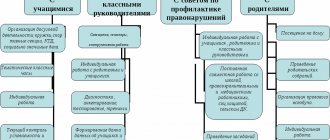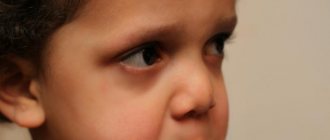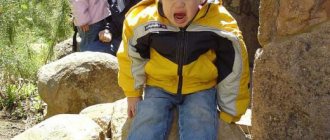Deviant behavior in children
Anastasia Zaitseva
Deviant behavior in children
Child with deviant behavior .
The concept of “Difficult child” is firmly rooted in the scientific vocabulary of pedagogy and educational psychology. This is the name given to a child with whom adults, primarily teachers, experience difficulties. In addition, this term is increasingly becoming a practical synonym for a pedagogically and socially neglected child.
The personality of a difficult teenager is formed depending on the type of nervous system, temperament, and all biological and mental components. The individuality of difficult-to-educate people is also determined by their lifestyle, which is unusually diverse for each of them.
1. In the character of a difficult-to-educate child, extreme opposites often coexist - a developed mind and almost undeveloped feelings (or vice versa, poorly developed hard work and overly developed needs, a limited outlook and a wealth of negative experience in everyday life, etc. This creates internal tension and inconsistency desires, which is expressed in contradictory actions.
2. Long-term conflictual relationships with others. Often behavior causes natural indignation among others and they react with critical remarks or negative attitudes towards his actions. The child regards this as hostile actions, as an attack on his independence. At first, conflictual relationships usually arise against the will of the child with some close person; they cause deep inner experiences and enhance introspection. Then the conflict environment expands and ends with completely damaged relationships with most adults and peers; then the child gets used to clashes and increasingly begins to blame others for this.
3. Selfish life position - that is, the child evaluates everything from the point of view of what is beneficial for him, what he will get for himself. The pursuit of pleasure, most often unhealthy, becomes the main stimulus for behavior .
4. Extreme instability of their interests and aspirations, changes in moods and desires.
5. Resistance to educational influences. Especially often, difficult children reject the demands of unloved teachers, those who accidentally or intentionally offended them or humiliated their personal dignity. If a child thoughtfully takes the path of counteracting the educational influences of teachers, then this indicates not only that the teenager is difficult to educate, but also serious mistakes in upbringing.
6. Unscrupulousness. For such children there are no firm moral standards. As a result, a mental and moral complex is born in which there is nothing stable. The child learns to maneuver in the world around him, to adapt, and he lives the way he wants.
Main types of difficult children .
1. Children with communication disorders.
Teenagers who, due to their exceptional position in the family (the only child, in the class group (unloved)
were deprived of normal communication.
These children are characterized by a distorted view of life - pessimistic, critical or overly romantic. Among such teenagers there are many unprincipled ones who do not recognize the rules of behavior .
2. Children with increased or decreased emotional response.
Children who have suffered severe nervous shocks. Characterized by increased excitability, acute reaction or passivity, indifference even to exciting events and phenomena, often affective behavior .
3. Children with one-sided mental development.
Teenagers whose mental development was inhibited or overly accelerated, whose abilities were ignored or overestimated. They are characterized by the inability to study correctly, to use their memory and abilities when studying material, hostility towards teachers who teach unloved subjects, etc.
4. Children with abnormal development of volitional qualities.
Inherent-volitional efforts are more regulated by self-hypnosis and emotional experiences than by the level of development of volitional qualities and the purpose of the activity; periods of intense willpower alternate with moments of complete lack of will; denial of the will of other people, resistance to it in almost all cases, or submission to the will of stronger people.
Deviant behavior.
A deviant is an individual who differs in his personal characteristics and behavioral manifestations from generally accepted norms: social, psychological, ethnic, pedagogical, age, professional and others.
Deviant behavior is a deviation from socio-psychological and moral norms, presented either as an erroneous antisocial pattern of conflict resolution, manifested in violation of socially accepted norms, or in damage caused to public well-being, others and oneself.
Signs of deviant behavior :
1. Deviant personal behavior is behavior that does not correspond to generally accepted or officially established social norms.
2. Deviant behavior and the person displaying it cause negative evaluation from other people (condemnation, social sanctions)
.
3. Deviant behavior causes real damage to the person himself or to the people around him. Thus, deviant behavior is destructive or self-destructive.
4. Deviant behavior can be characterized as persistently repeated (repeated or prolonged)
.
5. Deviant behavior must be consistent with the general orientation of the individual.
6. Deviant behavior is considered within the limits of the medical norm.
7. Deviant behavior is accompanied by phenomena of social disadaptation.
8. Deviant behavior has a pronounced individual and age-gender specificity.
The term " deviant behavior "
Can be used on children at least 5 years old.
Thus, deviant behavior is a stable behavior of an individual , deviating from the most important social norms, causing real damage to society or the individual himself, and also accompanied by social maladaptation
Deviations from social norms can be:
-positive, aimed at overcoming outdated norms or standards and associated with social creativity, contributing to qualitative changes in the social system;
-negative - dysfunctional, disorganizing the social system and leading to its destruction, leading to deviant behavior .
The main factors causing deviant behavior :
1. Biological factors are expressed in the existence of unfavorable physiological or anatomical features of the child’s body, which complicate his social adaptation. And here we are talking, of course, not about special genes that fatally determine deviant behavior , but only about those factors that, along with socio-pedagogical correction, also require medical correction. These include:
- genetic, which are inherited. These may be mental development disorders, hearing and vision defects, physical defects, and damage to the nervous system. Children, as a rule, acquire these lesions during the mother’s pregnancy due to poor and unhealthy nutrition, her consumption of alcoholic beverages, and smoking; diseases of the mother (physical and mental injuries during pregnancy, chronic and somatic infectious diseases, traumatic brain and mental injuries, sexually transmitted diseases); the influence of hereditary diseases, and especially heredity burdened by alcoholism;
- psychophysiological, associated with the influence on the human body of psychophysiological stress, conflict situations, the chemical composition of the environment, new types of energy, leading to various somatic, allergic, toxic diseases;
-physiological, including speech defects, external unattractiveness, shortcomings of a person’s constitutional and somatic make-up, which in most cases cause a negative attitude from others, which leads to a distortion of the person’s system of interpersonal relations among his peers and the team.
2. Psychological factors, which include the presence of psychopathology or accentuation in the child (excessive amplification)
individual character traits. These deviations are expressed in neuropsychic diseases, psychopathy, neurasthenia, borderline states, which increase the excitability of the nervous system and cause inadequate reactions of the teenager. Children with pronounced psychopathy, which is a deviation from the norms of human mental health, need the help of psychiatrists.
Children with accentuated character traits, which is an extreme version of the mental norm, are extremely vulnerable to various psychological influences and, as a rule, need social and medical rehabilitation along with educational measures.
Characterological teenage reactions, such as refusal, protest, grouping, are, as a rule, a consequence of emotionally dependent, disharmonious family relationships. If a teenager’s system of moral values is not formed, his sphere of interests begins to take on a predominantly selfish, violent, parasitic or consumer orientation. Such teenagers are characterized by infantilism, primitiveness in judgment, and a predominance of entertainment interests.
A person’s egocentric position with a demonstration of disdain for existing norms and the rights of another person leads to “negative leadership”
“enslavement”
on physically weaker peers , bravado with criminal
behavior , justifying one’s actions by external circumstances, low: responsibility for one’s behavior .
3. Socio-pedagogical factors - expressed in defects in school, family or public education, which are based on gender, age and individual developmental characteristics of children , leading to deviations in the early socialization of the child during childhood with the accumulation of negative experiences; in persistent school failure of a child with a severance of connections with school (pedagogical neglect, leading to unformed cognitive motives, interests and school skills in a teenager. Such children, as a rule, are initially poorly prepared for school, have a negative attitude towards homework, express indifference to school grades, which indicates both educational maladaptation.
4. Socio-economic factors include social inequality; stratification of society into rich and poor; impoverishment of a significant mass of the population, limitation of socially acceptable ways of earning a decent income; unemployment; inflation and, as a consequence, social tension. But this factor was discussed in more detail a little higher.
5. Moral and ethical factors are manifested, on the one hand, in the low moral level of modern society, the destruction of values, primarily spiritual, in the establishment of the psychology of “materialism”
, decline in morals;
on the other hand, in the neutral attitude of society towards manifestations of deviant behavior .
Thus, deviant behavior appears as a normal reaction to abnormal conditions for a child or a group of adolescents (social microsocial in which they find themselves, and at the same time. As a language of communication with society, when other socially acceptable ways of communication have exhausted themselves or are unavailable.
Currently, deviant behavior includes :
1. Delinquent behavior (deviant behavior with a clear antisocial orientation, which, in its extreme manifestations, acquires a criminal character);
2. Addictive behavior (deviant behavior with a desire to escape reality by taking psychoactive substances, or excessive fixation on certain types of activities);
3. Pathocharacterological behavior (deviant behavior caused by pathological changes in character due to defects in education);
4. Psychopathological (deviant behavior caused by
mental disorders);
5. Behavior based on hyperabilities (deviant behavior , accompanied by deviations in everyday life , with special talent and even genius in other areas of activity).
Prevention of inability to educate
Children-parents.
Includes a set of measures to prevent an undesirable phenomenon or event. These measures should be used when an adult sees or anticipates danger.
The most important measure is the creation of a family as a collective with a pronounced civic position of adults, which should be manifested in their actions and deeds on a daily basis, but not intrusively. And this position, first of all, is expressed in the hard work of parents. Any team influences the child through activities. Where children not only see the example of their parents in work, but also participate in it, helping adults, caring for them, difficult education is a rare occurrence. Work creates life experience - fertile ground for accepting the advice and admonitions of parents. Without this experience, all words do not have the power of pedagogical influence.
Marital happiness lies in the spiritual relationship between parents, parents and children. To raise children with your love, you need to be able to know a lot - to know yourself and your spouse, to grow spiritually yourself and help others become better, to make them believe in themselves and overcome their own shortcomings. In order to raise children correctly, it is important , first of all, to educate the father and mother in oneself.
Another source of enrichment of love is the aesthetics of nature, art, and creativity.
The family educates to the extent that it is complete as a happy, healthy and socially oriented team.
Teacher-student.
The ABC of education is emotional education. Emotional education at school begins with a high emotional culture in the teacher-student relationship. They are based on the teacher’s ability to have an emotional and aesthetic vision of the world, the ability to feel the spiritual world of another person. This means the ability to penetrate into the spiritual world of a child, the ability to understand the language of childhood and at the same time not be on the same level as the child in terms of his level of development. The emotional culture of the teacher is a condition under which such a method of influencing students as shouting becomes impossible. Children who are raised to scream lose the ability to sense the subtlest shades of other people's feelings, lose sensitivity and kindness.
The most important rule of the teacher-student relationship is to appeal to the good that is in every student, to approach him with an optimistic attitude. The teacher must instill in the child faith in his strength, in his capabilities, prove to him that he can be better and arouse in the student the desire for improvement.
The rule of the teacher’s attitude towards the child is respect for the student’s personality and self-esteem. The teacher has a certain power over the students, but at the same time this power must be wise (Not to break, but to lift and support, not to depersonalize the child’s spiritual strength, but to affirm his sense of dignity). The wise power of the teacher is to ensure that the will of the teacher becomes the desire of the child.
The next most important norm of relationships is mutual trust between teacher and student. The teacher's mistrust extinguishes the student's initiative and causes him mental suffering. As long as the child looks at the teacher with hope and believes him, the teacher is an authority. It is necessary to value children's trust. And for this it is necessary that the student feels the trust of the teacher.
An important regulator of teacher-student relationships is fairness in assessing students’ knowledge and actions. Injustice gives rise to their emotional insensitivity. Unfair treatment of a child can have many shades, and first of all it is the indifference, indifference of the teacher to the successes or failures of the child, which is one of the most severe forms of violence in terms of consequences. Experiencing indifference and lack of concern for oneself, the child loses sensitivity, becomes embittered and aggressive.
Correction of deviant behavior .
Re-education is a system of educational influences from teachers aimed at remaking the student’s incorrectly formed personality, at correcting those qualities, habits and traits that contradict the norms and requirements of society.
- overcoming internal contradictions, replenishing and correcting the mental development of a teenager.
-activation of positive behavior of a teenager by strengthening the educational process.
Diagnostics
Diagnosis of deviant behavior in adolescents is carried out by a psychiatrist and a medical psychologist. The diagnosis process is based on a number of clinical and psychological methods:
- Observation, conversation.
The psychiatrist interviews the patient: finds out living conditions, characteristics of family relationships, habits, hobbies. Evaluates the general condition, features of the emotional sphere, behavioral responses. - Interview with parents and relatives.
The psychiatrist listens to the complaints of people who are in close contact with the patient. The opinion of other people is important, since criticism of their own condition is often reduced in deviant adolescents. - Psychological testing.
A clinical psychologist asks a teenager to answer questions on tests and personality questionnaires. The Minnesota Multifactor Personality Inventory (MMPI), the Pathocharacterological Diagnostic Questionnaire (PDQ), the Eysenck Questionnaire, and the Anxiety Scale are often used. The result allows us to determine the dominant personality traits and character traits. - Projective techniques.
Used by a clinical psychologist to identify repressed emotions - aggression, fear, anxiety. Represented by drawing tests, Szondi test, Rosenzweig test.
Data from special diagnostic methods are supplemented by documentation from other specialists interacting with the teenager. When making a diagnosis, the psychiatrist takes into account the characteristics of school teachers, the local police commissioner, extracts from the outpatient card of the pediatrician, pediatric neurologist and doctors of other specialties.
Specifics of adolescence
Teenage children have their own characteristics. First of all, this is a marginal position (the transition from childhood to adulthood), the assimilation of new social roles, dependent or semi-dependent status, and the formation of values.
Among the characteristics of behavior and mentality:
- thirst for activity;
- ambition;
- a specific understanding of oneself and the world (contradictory and dual attitudes);
- interconnectedness, shared activity and group self-reflexivity;
- group consciousness;
- maximalism;
- demonstration of courage and originality;
- striving for the ideal;
- development of personal reflection;
- receptivity to any information and any volume of it;
- critical thinking;
- search for alternative options and your position;
- formation of subjective reality;
- plurality of social choices.
The leading activity of adolescence is interpersonal communication with peers. However, L.I. Feldshtein called socially useful activities the leading one. And communication with peers, according to the author, became the main thing when it was impossible to implement the first activity.
At this age, there is a conflict between the theory of a teenager (active value-creative activity) and the practice of the previous age (incomplete inclusion in society).
The instability and inconsistency of youth consciousness influence many forms of behavior and activity of the individual. Need I say that it is not easy to avoid deviations only against the background of natural age-related changes? All features of age can be called personal factors of deviant behavior. And if more negative external factors join in...
Specifics of teenage deviations
According to L.A. Rasudova, adolescent deviations may be associated with an insufficiently developed decentration mechanism (the ability to accept one’s social role and the roles of other people). Cognitive empathy and communicative interaction are directly related to this mechanism.
A. S. Gorbunova writes in her work that when identifying the causes and characteristics of deviations in adolescents, it is necessary to pay attention to the accentuation of the teenager’s personality. That is, those traits of his character that manifest themselves at the extreme limit of the norm and can, under certain conditions, develop into deviations. You can read more about teenage accentuations in my article “Character Accentuations in Adolescence.”
Teenagers with accentuations constitute a high-risk group. Knowing the type of accentuations, we can predict how this teenager will develop, as well as what conditions will contribute to the development or, conversely, extinction of these accentuations.
As a rule, deviations based on accentuations are solved by changing the situation. But with such deviations, it is important to take into account behavioral reactions, both characteristic of all ages and purely adolescent ones:
- emancipation;
- grouping with peers;
- enthusiasm;
- reactions based on the formation of sexual desire.
Alcoholism and drug addiction among youth
These two forms of deviant behavior among adolescents are more common than others.
Alcoholism is the excessive consumption of alcoholic beverages by minors, which threatens their physical and mental health; pathological addiction is addictive. There are many reasons for this: genetic predisposition, congenital syndrome, individual personality characteristics, unfavorable environment, curiosity. Also, teenagers drink alcohol due to a low level of development, lack of importance in the team, and insecurity.
To protect a child from the harmful effects of alcohol, you need to find him an exciting activity, as well as good friends who show examples of self-affirmation by other methods. The society has taken legal measures to prevent alcoholism among young people: a ban on the sale of alcohol to persons under 18 years of age, a fine for parents if their son or daughter appears drunk. Moreover, teaching children to drink alcohol is a crime punishable by administrative and criminal law.
Drug addiction is another deviation from the norm of behavior. It means the systematic use of intoxicating substances that cause deep and irreversible impairment of mental and physical functions. A teenager becomes dependent on pills, powders and injections due to the neglectful attitude of society towards him. Often, minors use drugs to express themselves or satisfy their curiosity. Drug addicts often turn to crime in order to illegally obtain money to buy a potion. Such children should undergo treatment in specialized institutions.
Three problems of deviantology
It seems that everything is extremely simple: there is normal, usual behavior accepted in society, and there is behavior that deviates either in a negative or in a positive direction.
But deviation is a much more complex phenomenon, and this complexity is determined mainly by three problems :
- The boundaries of a social norm are not precise, but rather conditional and blurred.
- The unsolvability of the dilemma “Freedom or Necessity?” The choice to act as one should, as dictated by society, moral and legal norms, or to act freely as one wants - in the end, remains a personal matter for everyone.
- There is simply no such thing as a citizen who is absolutely normal in all respects!
A person can, having committed a crime (negative deviation), save many people (positive result), and another, seemingly making a brilliant discovery (positive deviation), harm all of humanity (negative result).
Human behavior is relative and contradictory , it is very complex, multifaceted, determined by many factors, and therefore often cannot be assessed on a scale of “good and evil,” but there is no other evaluation criterion.
It is moral norms that determine who is to be condemned and punished and who is not, since they underlie written and unwritten laws. But judging a person strictly as “good” or “bad” is like looking at a three-dimensional cube from only one side and recognizing it as a flat square.
Criminals, hermits, revolutionaries, homeless people, geniuses, saints, discoverers - all these are deviants, that is, people who differ from the “average” in character and behavior.
Deviant can be not only an individual, but also a group of people, a community, an organization or a subculture.
Prevention
Psychological trainings help to integrate into the team and avoid the development of deviance in children and adolescents
- Conversations and lectures held in a friendly and welcoming atmosphere. This is important to build trust in the child. It is necessary to teach the child how to act in a given situation in the presence of conflicts. It is important to provide real examples. These conversations should encourage the child to lead a healthy lifestyle and arouse an aversion to alcoholic beverages and drugs.
- Proper organization of free time. You need to teach your child that rest time should be spent having fun playing. In addition, it is useful to go into nature or visit a cultural place, read a book.
- Psychological trainings. They help the child learn to communicate with peers, be able to set priorities correctly, and cope with complex tasks with ease.
- Educational programs help to form the right attitude towards others and teach a healthy lifestyle. They talk about the prevention of sexual deviations and early sexual intercourse.
Now you know what constitutes deviant behavior of minors. Having found out the reasons for the development of deviance and how it manifests itself, parents are able to notice in time and prevent the formation of deviation in their offspring with timely actions. You need to understand what the consequences of a neglected condition may be, that without correction the situation will only worsen, the risk to the child’s health will significantly increase, or the child will become dangerous to society.
Specifics of childhood
Children are characterized by:
- activity;
- purposefulness (sometimes manifested in the form of stubbornness);
- desire to imitate;
- craving for a peer group (“to be like everyone else”);
- sense of responsibility and duty;
- frankness (openness);
- passion;
- emotionality;
- desire for recognition among peers and adults;
- feeling of empathy.
Self-esteem begins to develop (depending on the assessment of an adult), reflection, and the desire to work independently from an adult, but in a team.
It is worth noting that each personal quality has an opposite characteristic, therefore, for certain reasons (pedagogical neglect, unfavorable social environment), children can be irresponsible, weak-willed, embittered, and so on.
The leading type of activity is educational. The social situation of development is communication with the team and communication with adults (parents and teacher). The child's relationship with the teacher (who is a reflection of society) serves as the basis for the child's relationship with parents and peers.
The main task of age (contradiction) is the transfer of moral (that is, abstract) social norms and values into personal ones. This happens due to actively developing verbal and logical thinking. As a rule, in any activity, children are not interested in the result, but in the process itself.
This is also a period of active development of self-awareness, imagination and memory. All actions of a child at this age are conscious and voluntary. Younger schoolchildren focus on the present and only a little on the near future (for example, they look at teenagers with envy and the desire to become the same).
Signs
Aggressive behavior is a sign of developing deviance
It is important to know about the existence of characteristics of deviations for a certain age period. This will make it easier to identify the possible development of deviant behavior:
- up to seven years of age, nervousness, irritability, problems of academic failure, consistency, aggressive behavior are non-standard, sometimes self-doubt and timidity become an alarming symptom;
- from seven to ten years - boorish character, conflict, stiffness, loss of appetite;
- children over ten years old - hooliganism, vagrancy, theft.
According to statistics, crime is more common among people between 13 and 20 years old. Alcoholism is typical for the age period from thirteen to sixteen years.
Children consider the goal of their life to be the achievement of material wealth, and they do not think about what price they have to pay for it. Recently, the desire to study or work has decreased, and the level of teenage crime has increased. Young people are trying to assert themselves and attract the attention of their peers. Deviant behavior often leads to nervous breakdowns and may include suicidal tendencies.
If a child is physically underdeveloped, overweight, or, on the contrary, too thin, he hears ridicule from others and ridicule from peers. Preschoolers are most prone to developing stress; their psyche is unstable.
- The child will try to join the team, committing unjustified actions, including risky ones, showing aggression towards others, may start running away from home, and will eventually skip school.
- Teenagers tend to display unstable moods, express aggression, and stubbornness.
Let's look at how deviant behavior can manifest itself in different types.
- Hyperkinetic disorder. Characterized by mental stress, lack of perseverance, recklessness, the habit of not finishing what is started, and impulsiveness. Such children often receive disciplinary action and have accidents.
- Delinquent behavior. The teenager steals vehicles, engages in fraud and theft.
- Deviations are observed at home and are limited to family relationships. The child is rude to his parents, steals things, and can set the house on fire.
- Socialization disorder. It occurs in fairly sociable adolescents with antisocial behavior. A teenager may join bad company, leave home, and start engaging in extortion. If there is a mental disorder, mood swings will appear, aggressive and depressive.
- Intimate. Disorders can arise due to accelerated or delayed puberty, which will be manifested by exhibitionism, manipulation of other people's genitals, and teenage homosexuality.










